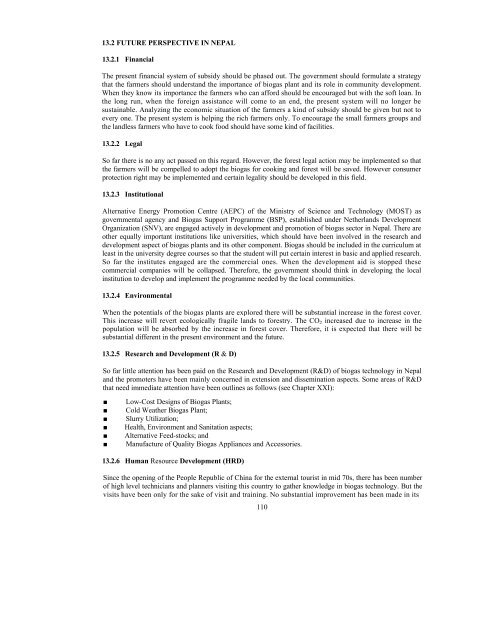download (pdf, 6MB) - SNV
download (pdf, 6MB) - SNV
download (pdf, 6MB) - SNV
You also want an ePaper? Increase the reach of your titles
YUMPU automatically turns print PDFs into web optimized ePapers that Google loves.
13.2 FUTURE PERSPECTIVE IN NEPAL<br />
13.2.1 Financial<br />
The present financial system of subsidy should be phased out. The government should formulate a strategy<br />
that the farmers should understand the importance of biogas plant and its role in community development.<br />
When they know its importance the farmers who can afford should be encouraged but with the soft loan. In<br />
the long run, when the foreign assistance will come to an end, the present system will no longer be<br />
sustainable. Analyzing the economic situation of the farmers a kind of subsidy should be given but not to<br />
every one. The present system is helping the rich farmers only. To encourage the small farmers groups and<br />
the landless farmers who have to cook food should have some kind of facilities.<br />
13.2.2 Legal<br />
So far there is no any act passed on this regard. However, the forest legal action may be implemented so that<br />
the farmers will be compelled to adopt the biogas for cooking and forest will be saved. However consumer<br />
protection right may be implemented and certain legality should be developed in this field.<br />
13.2.3 Institutional<br />
Alternative Energy Promotion Centre (AEPC) of the Ministry of Science and Technology (MOST) as<br />
governmental agency and Biogas Support Programme (BSP), established under Netherlands Development<br />
Organization (<strong>SNV</strong>), are engaged actively in development and promotion of biogas sector in Nepal. There are<br />
other equally important institutions like universities, which should have been involved in the research and<br />
development aspect of biogas plants and its other component. Biogas should be included in the curriculum at<br />
least in the university degree courses so that the student will put certain interest in basic and applied research.<br />
So far the institutes engaged are the commercial ones. When the development aid is stopped these<br />
commercial companies will be collapsed. Therefore, the government should think in developing the local<br />
institution to develop and implement the programme needed by the local communities.<br />
13.2.4 Environmental<br />
When the potentials of the biogas plants are explored there will be substantial increase in the forest cover.<br />
This increase will revert ecologically fragile lands to forestry. The CO 2 increased due to increase in the<br />
population will be absorbed by the increase in forest cover. Therefore, it is expected that there will be<br />
substantial different in the present environment and the future.<br />
13.2.5 Research and Development (R & D)<br />
So far little attention has been paid on the Research and Development (R&D) of biogas technology in Nepal<br />
and the promoters have been mainly concerned in extension and dissemination aspects. Some areas of R&D<br />
that need immediate attention have been outlines as follows (see Chapter XXI):<br />
■<br />
■<br />
■<br />
■<br />
■<br />
■<br />
Low-Cost Designs of Biogas Plants;<br />
Cold Weather Biogas Plant;<br />
Slurry Utilization;<br />
Health, Environment and Sanitation aspects;<br />
Alternative Feed-stocks; and<br />
Manufacture of Quality Biogas Appliances and Accessories.<br />
13.2.6 Human Resource Development (HRD)<br />
Since the opening of the People Republic of China for the external tourist in mid 70s, there has been number<br />
of high level technicians and planners visiting this country to gather knowledge in biogas technology. But the<br />
visits have been only for the sake of visit and training. No substantial improvement has been made in its<br />
110
















